Designing for voice: a report on voice UI
Discover how, when, and why to tap into the voice UI opportunity with our detailed report.
Why it's worth bringing voice to your brand
To guide the recommendations in this report, we ran UK-wide research on voice usage which showed us that:
- People are engaging with voice interactions
Even we were surprised at the level of engagement. Only a few of the people we surveyed weren't aware of voice assistants like Alexa or Apple Siri. Out of those aware, 75% are actively using at least one voice assistant, often multiple times a day. - Voice assistants are taking over the home
Most people said they're engaged with voice interactions in the comfort of their own home. Voice assistants are often found in living rooms, kitchens, and bedrooms, and many people have more than one, opening the door to many interesting use cases. - People are open to new use cases for voice interactions
Obvious and simple use cases, such as controlling music playback or checking the weather, have already achieved a lot of traction. Whilst mindful of privacy and security concerns, people are still open to future use cases around more complex domains, including learning, health, and finance.
To succeed, design the product around real user needs and test and iterate with them throughout
Getting started with voice
To succeed in this exciting space, it's important to go back to user-centred principles. People will be interacting with your brand for a reason; they'll have a goal they need to achieve (booking or buying something, entertaining themselves, finding information etc.).
Voice will likely be just one of a number of ways in which users can complete their goal, competing with using your website or app, making a call or visiting you in person. They'll only choose voice if it's either easier for them than other channels or allows them to do something they couldn't do before.
Informed by our work with clients, and further supported by our research provides:
- Guidelines to help you scope out which use cases might be suitable for voice
- A set of voice design principles
These will help guide the design of voice interfaces but, as always, the way to succeed is to design the product around real user needs and test and iterate with them throughout. If a voice app doesn't help users achieve a goal, solve a problem, or provide a moment of delight, it may quickly become an unused gimmick.
Putting voice to good use
Regardless of the importance to your business, not all use cases will be equally suited to voice. Use the following checklist to help you decide:
- Is it faster than doing on another channel?
(For example, on a phone or laptop, considering also the time it takes to unlock, find app, login) - Does it cut out multiple steps?
(Can people say in a sentence what would take multiple steps to go through in an app or website?) - Can you make it fun and engaging?
(Would injecting some of personality through voice make interacting with your brand better?) - Is it suitable for multi-tasking?
(Does it need the user's full attention? What would happen if they got distracted?) - Is it a 'push' or 'pull' interaction?
(Is it something that people initiate? Voice assistants aren't (yet) optimised for delivering notifications) - Is it appropriate for a shared home device?
(Will people worry about privacy, saying something out aloud or being recorded?) - Can people discover and remember it?
(Does your use case have a name that's memorable and easy to say out aloud?) - Is it frequent enough?
(Will people want to access it often enough to warrant installing a voice app? Or is it mainly one-off?) - Is your data structured?
(Is the data needed for this use case accessible through a database or API? Or is it just unstructured text?
Voice. It’s the Future.
Interacting with computers using voice used to be the preserve of science fiction films.
As you’re reading this, hundreds of people around the world are asking their phones or voice-enabled home devices to play music, switch on lightbulbs, or suggest recipes.
But for this to progress beyond gimmicks, brands need to make sure that voice interactions are useful, appropriate and designed around real user needs. Based on the work we’ve done so far with our clients and our proprietary research, we’ll show you the way forward to making voice part of your digital strategy.
Voice in a few words
Here's why it’s worth bringing voice to your brand:
| People are engaging with voice interactions | Voice assistants are taking over the home | People are open to new use cases for voice interactions |
|---|---|---|
| Even we were surprised at the level of engagement, only a few of the people we surveyed weren’t aware of voice assistants like Alexa or Apple Siri. | Most people said they’re engaged with voice interactions in the comfort of their own home. | Obvious and simple use cases, such as controlling music playback or checking the weather, have already achieved a lot of traction. |
| Out of those aware, ¾ are actively using at least one voice assistant, often multiple times a day. | Voice assistants are often found in living rooms, kitchens, and bedrooms, and many people have more than one, opening the door to many interesting use cases. | Whilst mindful of privacy and security concerns, people are still open to future use cases around more complex domains, including learning, health, and finance. |
Insights are based on a Webcredible, part of Inviqa, survey of 524 UK adults across the UK, conducted in February 2018.
How do I start?
To succeed in this exciting space, it’s important to go back to user-centred principles.
People will be interacting with your brand for a reason – they’ll have a goal they need to achieve. This could be booking or buying something, entertaining themselves or finding information.
Voice will likely be just one of a number of ways in which users can complete their goal, competing with using your website or app, making a call or visiting you in person.
They’ll only choose voice if it’s either easier for them than other channels or allows them to do something they couldn’t do before. Informed by our work with clients, and further supported by our research, we’ve created:
- Guidelines to help you scope out which use cases might be suitable for voice
- A set of voice Design Principles
These will help guide the design of voice interfaces but, as always, the way to succeed is to design the product around real user needs and test and iterate with them throughout. If an app doesn’t help them achieve a goal, solve a problem, or provide a moment of delight, it may quickly become an unused gimmick.
How do I put voice to good use?
Regardless of the importance to your business, not all use cases will be equally suited to voice.
Use the following checklist to help you decide:
| 1 | Can a voice interaction be faster than taking out your phone or laptop? |
| 2 | Is it easier than tapping, typing or going through multiple steps? |
| 3 | Is there a potential for fun, delight or expressing your brand’s personality? |
| 4 | Is it conducive to multi-tasking, where people might not give the task 100% of their attention? |
| 5 | Is it a use case that will be initiated by customers, instead of you reaching out to them? |
| 6 | Is it appropriate for voice and for a shared home device? Will people feel comfortable talking aloud about it? |
| 7 | Does it have a name that people can remember (and you can promote)? |
| 8 | Is interaction frequent enough to warrant people installing something on their voice device? |
| 9 | Is your content structured and accessible through an API? |
The majority has interacted with voice technologies
The majority of UK consumers are using their voice to interact with their smartphone and home devices. Regular interaction is much higher for home devices like Amazon Echo and Google Home than mobile voice assistants such as Apple Siri and Google Now.
Voice is a growing channel, providing more opportunities for brands to interact, engage and deliver wow moments to their customers
More people have tried out voice interactions on their mobile devices
More people have used mobile voice assistants (such as Apple Siri or Google Assistant) than home voice assistant devices such as Amazon Alexa and Google Home, albeit less frequently.
This isn’t unexpected given that most smartphones and tablets come with a voice assistant built in. Voice-enabled devices for the home are still moving from early adopters into mainstream.
However, familiarity with mobile voice assistants means that people won’t be starting from scratch when it comes to interacting with voice-enabled devices for the home.
We also found that Alexa-enabled devices are more popular than Google Home. Again, this is to be expected given Amazon released Alexa a couple of years ahead of Google Home and has executed extensive advertising campaigns to support its continued growth of market share.
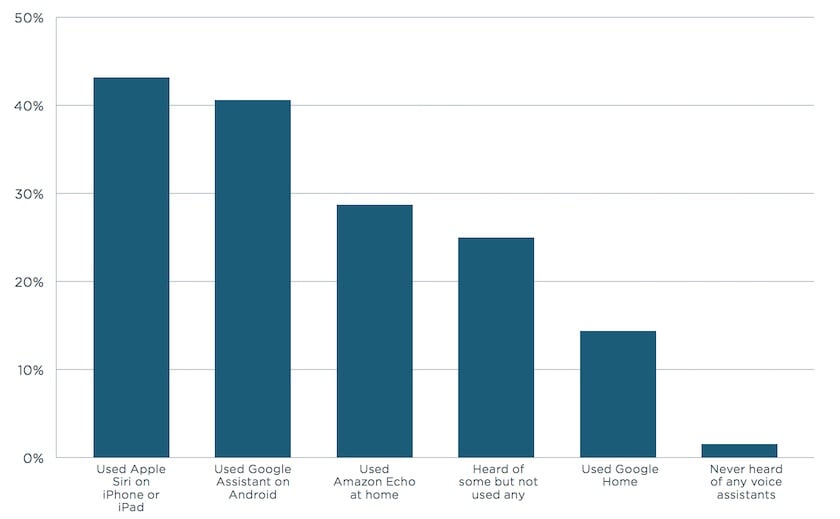
Regular voice-enabled interactions at home
Although many people own a mobile device with a voice assistant, voice is more frequently used at home.
This seems to be because:
- There are plenty of apps for early adopters to experiment with on home devices, whereas assistants like Apple Siri still have a limited repertoire
- People are less concerned about using voice in a private space
It seems that mobile voice assistants are struggling to gain traction even though most users have more widespread access and have tried them. This isn’t to say there isn’t opportunity for growth in that area, but a lot of this depends on manufacturers like Apple opening up more possibilities for voice 'apps'.
Overall we see that the biggest opportunity for brands is to develop Alexa Skills and Google Actions for use in the home.
Users have actively chosen to buy their device, they’re engaged and being in the comfort (and privacy) of their own home is an important motivation in interacting with voice assistants.
I would like Apple Siri to be able to book tickets for events for me, sport, cinema
We’re interacting with our home voice assistants more frequently than with the mobile ones.
How often do you speak to Alexa or Google Home?
 How often do you use Apple Siri or Google Assistant on your phone?
How often do you use Apple Siri or Google Assistant on your phone?

Who is interacting with voice and where?
Families are leading the charge with voice at home.
People are much more likely to interact with devices using voice at home than in public environments, such as when at work or travelling.
Users of all ages are embracing voice interactions and there’s higher than average ownership of home voice assistants amongst families.
Think about apps that lend themselves to the home environment and be sensitive to privacy if used in more public spaces.
Even mobile voice assistants are used more often at home than out and about
People prefer to use mobile voice assistants in more private environments, most commonly at home on their own (88%) or at home with others (44%). Interaction in environments like the workplace were much less likely (9%), meaning it may be more of a challenge to convince people to use voice apps in the B2B space.
It’s particularly interesting that, in situations where hands-free interaction would be a benefit, such as walking, cycling, driving or exercising, the use of mobile voice assistants was less common despite the obvious benefit!
Consider people’s needs and goals when on the move – is there a way of better supporting these through voice?
Home voice assistants are used throughout the house
The living room is the most common place in the home for people to have their home voice devices. This is expected given most of these devices double up as smart speakers.
However, it is interesting to see that users have their devices all over the house, from the kitchen to the bedroom and even the bathroom.
This opens up more opportunity to think about how users could interact with your brand in different rooms, in different situations. Don’t just assume the device is confined to the obvious places!
Families are leading adopters of home voice assistants
Those ‘living with partners and kids’ are more likely to own and use home voice assistants than those living alone or with a partner.
This makes a lot of sense when you consider some of the more common contexts of use, such as playing music and asking questions.
Voice also lends itself to busy lifestyles providing information quickly, keeping you on track, and allowing you to add olive oil to that shopping list without having to stop cooking!
From young to old, we are embracing Voice
There’s take-up across most ages of one or more voice devices. In fact, we’ve seen that voice interactions can be less intimidating for people in older age groups who haven’t yet got fully familiar with screen-based interfaces, or where age-related disabilities hinder the use of a screen and pointing device.
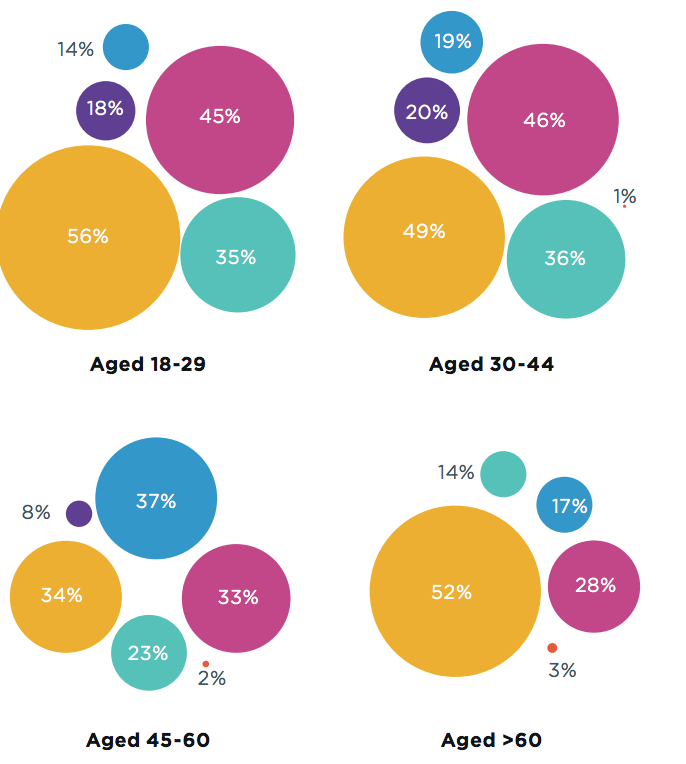
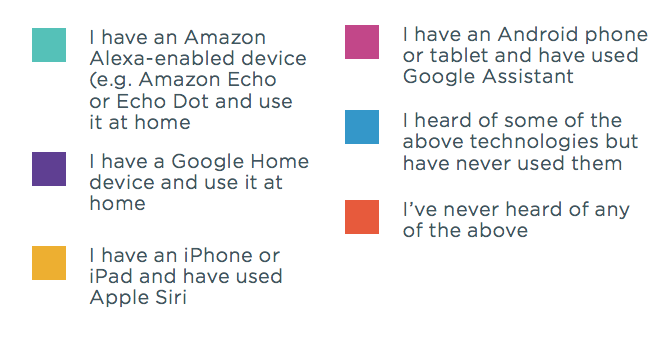
Spotlight: Amazon Alexa & Ageing
Since Amazon launched Alexa in late 2014, it has amassed a surprisingly high following amongst aged people and their carers.
Throughout 2017, the Front Porch Center for Innovation and Wellbeing in the US ran a pilot programme distributing Amazon Echo devices to residents of a retirement community. 75% of residents used their devices at least once a day, and 60% said they felt more connected to family, friends and their community since starting the pilot. All agreed that it 'made their life easier' and 'would recommend it to a friend'.
To look at it from a human standpoint: what do we use to get messages across, to communicate? It’s your voice!
Age UK, a leading charity helping people love later life, has already made its popular radio station available to stream through Alexa, and we’re helping the organisation explore further use cases around voice interactions.
It has afforded me something that I have lost: memory. I can ask Alexa anything and I get the answer instantly
What are people using voice for?
Core use cases such as controlling music playback, checking the weather and asking questions enjoy high adoption across both home and mobile voice assistants. Alongside that, there’s a diversity of up-and-coming use cases, including smart home and ecommerce.
A variety of popular tasks across all voice assistants
| Alexa / Google Home | Apple Siri / Google Assistant | ||
|---|---|---|---|
| Playing music | 82% | Asking about general facts/trivia | 64% |
| Checking the weather | 62% | Checking the weather | 48% |
| Asking about general facts/trivia | 54% | Playing music | 39% |
| Adding things to a shopping list | 37% | Getting directions | 35% |
| Getting the latest news | 35% | Communicating with others | 30% |
| Smart home commands | 35% | Adding things to a list | 12% |
| Communicating with others | 30% | Smart home commands | 7% |
| Checking transport information | 25% | Making payments/sending money | 7% |
| Ordering takeaway food | 25% | Other | 5% |
| Buying things | 23% | ||
| Playing a game | 21% | ||
| Other | 2% |
Although more complex tasks such as those involving purchasing were much less common, this will likely change as both brands and technology providers iterate and offer new solutions.
For example, Virgin Trains has just become the first travel company in the world to sell tickets through Alexa using Amazon Pay, which uses saved payment information from the customer’s Amazon account to speed up the purchasing flow.
The biggest challenge for brands is finding a use for voice that facilitates an easier journey than using other channels and therefore, serves a real need.
A second challenge is differentiating your app from what native services like Google Assistant and Alexa already offer, so that it’s truly unique for the user.
A blend of emotional & functional needs
Since the adoption of voice technology has only recently accelerated, many people are still using it because 'it’s fun'. The obvious danger here is that the novelty wears off and usage of voice isn’t sustained.
Voice can offer conversational and fun interactions but equally, where appropriate should be serious, supportive and empathetic.
There is opportunity to provide advice, health support and other services based on conversations and supported by Artificial Intelligence.
I’d like my Amazon Alexa to counsel me when I am upset
In our research alone, 21% of those with home voice devices said that voice interactions stopped them feeling lonely and as the technology becomes even more advanced, these more natural conversations are likely to increase.
Key benefits are fun, speed and ease of use
| Alexa / Google Home | Apple Siri / Google Assistant | ||
|---|---|---|---|
| It’s a fun experience | 65% | It’s easier to speak than type | 60% |
| It’s easier to speak than type | 62% | I can use it hands-free | 55% |
| I can use it hands-free | 57% | It’s a fun experience | 40% |
| It’s faster than using another device | 54% | I don’t get any benefits | 7% |
| I don’t have to carry another device | 27% | It stops me from feeling lonely | 5% |
| It stops me from feeling lonely | 21% | Other | 1% |
| I don’t get any benefits | 4% | ||
| Other | 1% |
Some people still don’t see the point
Almost a quarter of respondents haven’t used any voice assistants, even though they’re aware of them. The top reason cited was the lack of interesting use cases that people could identify with.
Some people also mentioned the cost of additional voice-enabled devices, as well as disliking speaking to a device, but these reasons were far behind the top one.
Privacy is a key concern
Even though many people have tried voice interactions at home, privacy still is a big concern. Interestingly, these worries are higher for home devices like Amazon Alexa or Google Home, than for Apple Siri or Google Assistant on mobile. Some people are worried their conversations are being recorded or that ‘Alexa is always listening’.
You should always look at these concerns through the lens of your own use case.
Will your voice app ask for confidential information, or things that people don’t want to say out aloud? Other frustrations and barriers to use centre around the accuracy of speech recognition, and a few people simply thinking that 'it feels stupid talking to a device'.
I would like to check my financial balances but do not trust it enough at the moment.
Learning, health & finance
As part of our research, we chose to explore use cases in three areas currently under-served by voice interactions, both on mobile and home devices. These were:
- Learning
- Health
- Finance
We were curious to understand how users felt about using voice interactions in complex domains that go beyond getting answers, playing music and simple appliance commands.
Each of these involves exchanging more personal data, and an increasingly higher level of risk in case something goes wrong.
However, people’s responses demonstrated that few areas are off-limits for voice, and that there is a willingness to try novel experiences in a variety of domains.
Learning
Out of all the use cases we explored, people were most open to using voice interactions to learn and test their knowledge.
This doesn’t have to just be about learning general skills, it can also be about educating users around your sector, your products or any subject where there may be a gap in their knowledge. For younger generations (under 21), voice interactions are the norm. It doesn’t feel strange or alien, and they have no reason not to trust it as a channel. It is worth exploring further how your brand could engage with this audience, and therefore their parents, through voice.
Health
Given the potential privacy concerns, people were more open than we expected to using voice interactions for general health advice, as well as accessing more personalised health services.
Some of the scenarios that people could imagine for their voice assistants include:
- Acting as a 'life coach'
- Playing the role of a 'companion'
- Prompting people to exercise and follow a healthy diet
Some are already getting health advice through voice interactions (34% of home voice assistant users) and there is clear appetite to use it more. Because people tend to listen to health advice from other people, voice interactions feel like a natural extension to that and are definitely worth exploring.
Finance is a sensitive area
Appetite for voice interactions around more personal financial matters was lower than for learning and health. But there is potential to improve this.
Almost half remain to be convinced that it would be a good idea to ask a voice-activated device to read out their bank balance.
Those living alone were more open to trying this, showing that privacy is a key concern around finance.
Security is another concern likely to crop up in such scenarios, but with major banks already trying out voice-based authentication, it’s only a matter of time until such technology is built into voice assistants and people are comfortable with using it.
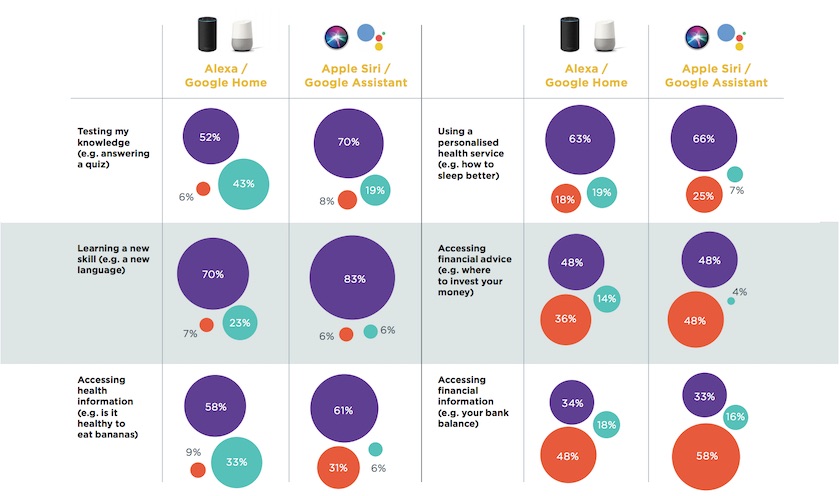
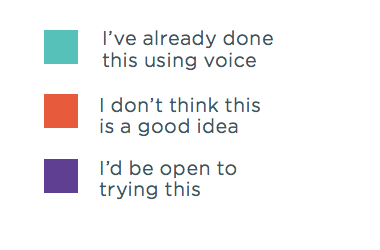
How you can design for voice
Creating your own voice enabled app
As with the design of any successful product, you should start with understanding both business and user goals and challenges, which will form the basis for your design.
Based on our research, and our ongoing work with clients to design voice apps, we’ve developed a set of principles for designing for voice.
Use them to guide the design of voice interactions, but always complement them with additional research with your target audiences to establish their specific attitudes and behaviours when it comes to voice.
Voice Design Principles:
- Make it more efficient than using other channels
- Make it sound natural (not like a phone menu)
- Give it some personality and find the right tone of voice
- Design for the worst case
- Not everything has to be done through voice
Make it more efficient than using another channel
When thinking of creating a voice app, consider whether it can offer functionality that is quicker and easier to do through voice than any of your other channels.
If it isn’t, your idea probably isn’t that strong and people won’t adapt to the use. Think of tasks that are well-suited to voice interactions, such as retrieving information quickly or facilitating an immediate action. Many of these tasks can also be done quickly enough on a phone or a laptop, but the process of picking up a device, finding an app or website adds a lot of time on top of executing the actual task.
On the other hand, voice assistants are always on and ready to respond.
'Alexa, ask Ocado to add onions to my order' is much quicker than: 1. Picking up a phone 2. Unlocking it 3. Finding and opening the Ocado app 4. Typing 'Onions' 5. Tapping 'Add to order'
Make it sound natural (not like a phone menu)
People have had enough bad experiences with robotic-sounding menus when they ring up contact centres, and you certainly don’t want your brand to feel like that.
When you have a scenario for a voice interaction, don’t just write it down. Instead, create a first 'prototype' of your voice app by reading it out loud, and even acting it out in pairs (with one of you playing the role of a voice assistant).
Look out for awkward moments and things that feel strange to say aloud. If your way of saying something doesn’t sound natural in a conversation between two humans, it probably isn’t right for your voice app either.
Human conversation sounds natural because it contains a lot of variety - there are many ways to say the same thing. If you program your voice app to generate a variety of responses, it will also sound more like a human and less like a robot.
Give it some personality and find the right tone of voice
At the moment many people are interacting with voice assistants because they’re novel and 'fun'.
It’s fine to consider ideas that will make your app more fun, playful and memorable. This will increase the chance of people talking about your brand with others, especially if brand awareness is an objective of your voice app.
Ultimately, however, your app must exist to serve a user need and should adapt its tone of voice as appropriate.
For example, while researching to inform the design of the Virgin Trains Skill we established two key findings relating to the tone of voice:
- People like conversational banter when their train is on time and all is good with their travel plans
- People want to get more empathy and support when their train is late or cancelled.
Voice apps and the associated tone of voice should mirror real life situations in order to provide the best user experience.
Design for the worst case
As you make your brand feel more ‘human’ through voice interactions, people will also have higher expectations about its capabilities. So it’s even more important to consider what happens when things go wrong, as well as when they go right.
Many of the use cases for voice look deceptively simple when considering the best case: the user makes a request, voice assistant answers any follow-up questions and gets to a successful conclusion. But there’s a lot that can go wrong. The user’s voice may not be recognised correctly (a common frustration amongst the people who answered our survey). People may get distracted in the midst of a conversation. Back-end systems might fail and return no data.
Helping people recover from such situations gracefully will truly set your voice app apart from others.
Not everything has to be done through voice
We’ve heard from a few of our clients that they’d like to get started with voice interactions but their use cases are just 'too complex for voice'. This needn’t be a blocker.
Your first voice app doesn’t need to cover all stages of your customer journey. Instead, map out how voice experiences can be part of a larger journey that can start or finish on other channels or devices.
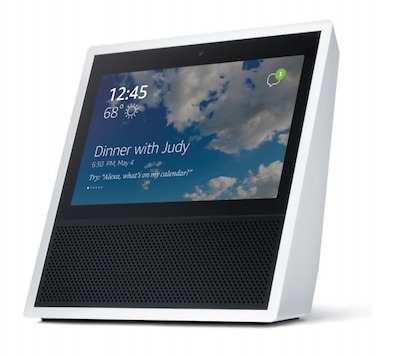 For example, a long sign up process may be tedious and confusing when done through voice, but if part of the journey is done online then a voice experience can take over where appropriate.
For example, a long sign up process may be tedious and confusing when done through voice, but if part of the journey is done online then a voice experience can take over where appropriate.
You should take advantage of account features like Amazon Pay, which now lets voice assistant users use their saved payment information instead of having to say it aloud. Some voice assistants also come with screens, which can be used to display additional information.
Why and how we ran this research
There’s little research around the use of voice assistants in the UK, and much of it is biased towards promoting a particular brand or the industry as a whole. As an impartial, insights-based advisor to our clients we wanted to dig a bit deeper.
In February 2018, we carried out a survey of 524 UK adults across the UK, conducted online through the SurveyMonkey panel.
The survey questions reflected our interests in finding out:
- Whether voice presents a serious market opportunity
- The differences between the usage of voice assistants both inside and outside the home
- What motivates people to use voice interactions vs. other channels
- The kind of tasks that are more popular through voice
- Where opportunities for innovation lie





